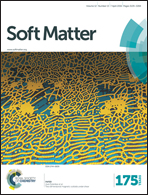Deformation and internal stress in a red blood cell as it is driven through a slit by an incoming flow
Abstract
To understand the deformation and internal stress of a red blood cell when it is pushed through a slit by an incoming flow, we conduct a numerical investigation by combining a fluid–cell interaction model based on boundary-integral equations with a multiscale structural model of the cell membrane that takes into account the detailed molecular architecture of this biological system. Our results confirm the existence of cell ‘infolding’, during which part of the membrane is inwardly bent to form a concave region. The time histories and distributions of area deformation, shear deformation, and contact pressure during and after the translocation are examined. Most interestingly, it is found that in the recovery phase after the translocation significant dissociation pressure may develop between the cytoskeleton and the lipid bilayer. The magnitude of this pressure is closely related to the locations of the dimple elements during the transit. Large dissociation pressure in certain cases suggests the possibility of mechanically induced structural remodeling and structural damage such as vesiculation. With quantitative knowledge about the stability of intra-protein, inter-protein and protein-to-lipid linkages under dynamic loads, it will be possible to achieve numerical prediction of these processes.


 Please wait while we load your content...
Please wait while we load your content...